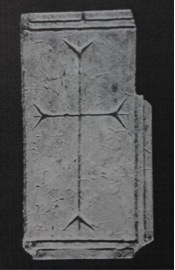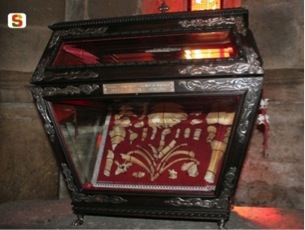Reliquary lid
A rectangular reliquary lid made from bone, with an engraved cross on it and dated to the 7th century A.D. was found in the cemetery area of San Saturnino. It is currently on show at the National Archaeological Museum of Cagliari (fig. 1).
Reliquaries (in wood, bone, and also silver and other precious metals, figs. 2-3) are small containers similar to a small box, inside which the remains of saints were kept. These were generally made from fragments of bone (fig. 4) but there are many cases where they hold fragments of garments or items that belonged to the saints. The main function of the reliquaries was to conserve and keep the holy remains, and possibly also to exhibit them to the faithful as items to be venerated.

Fig. 1 - Cagliari, S. Saturnino: reliquary lid with an engraved cross (From Salvi 2002, fig. 99, p. 291).

Fig. 2 - Silver reliquary of Sant’Apollinare, 6th-7th century (From https://www.buonconsiglio.it/index.php/Castello-del-Buonconsiglio/collezioni/Arte-medievale).

Fig. 3 - Silver reliquary from the church of Sant’ Andrea, Rimini, 5th-6th century (From http://www.crocifisso.rimini.it/storia/).

Fig. 4 - Reliquary containing the remains of Santa Giusta, Basilica of Santa Giusta, S. Giusta (http://www.sardegnadigitallibrary.it/index.php?xsl=626&id=48684).
Bibliografia
- D. SALVI, Cagliari: San Saturnino, le fasi altomedievali, in Ai confini dell’Impero. Storia, arte e archeologia della Sardegna bizantina, Cagliari 2002, pp. 225-229.
- V.H. ELBERN, s.v. reliquiario, in Enciclopedia dell'Arte Medievale, 1998.

 VR
VR